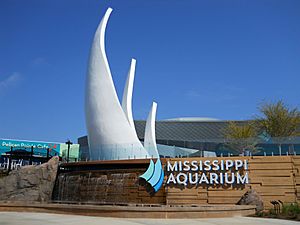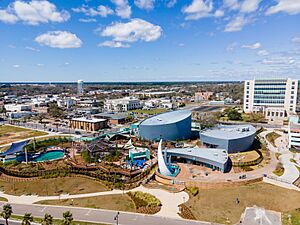Mississippi Aquarium facts for kids
 |
|
 |
|
| Date opened | August 29, 2020 |
|---|---|
| Location | 2100 E. Beach Boulevard, Gulfport, Mississippi, United States of America |
| Land area | 5.8 acres (2.3 ha) |
| Coordinates | 30°22′4″N 89°5′18″W / 30.36778°N 89.08833°W |
| No. of species | >200 species of fish and other animals plus 50 species of native plants |
| Total volume of tanks | over 1 million US gallons (3,800 m3) of saltwater and freshwater |
| Major exhibits | 12 |
The Mississippi Aquarium is a fun and educational place in Gulfport, Mississippi. It's a public aquarium that opened on August 29, 2020. This special date was also the 15th anniversary of Hurricane Katrina. The aquarium replaced an older one called the Marine Life Oceanarium, which was damaged by the hurricane. The Mississippi Aquarium covers about 5.8 acres. It has both indoor and outdoor areas where you can see over 200 different kinds of animals. You can also discover more than 50 types of plants that grow naturally in the area.
Contents
Building the Aquarium
How the Mississippi Aquarium Was Built
Work on the Mississippi Aquarium officially began on May 11, 2018. The main design for the aquarium was created by Eley Guild Hardy Architects from Biloxi. They worked with PGAV Destinations from St. Louis and Brown, Mitchell & Alexander, Inc. from Gulfport/Biloxi.
Funding the Project
Building the aquarium was a big project that cost about $93 million. This money covered buying the land, designing the buildings, and all the construction. Most of the money, about 90%, came from public sources. This included the City of Gulfport, the State of Mississippi, and special grants like the RESTORE Act funds. The rest of the money, about 10%, came from private donations through the Mississippi Aquarium Foundation.
What You Can See and Do
Exciting Exhibits and Habitats
When you visit the Mississippi Aquarium, you'll notice three sail-like shapes at the entrance. These shapes are also part of the aquarium's logo. The aquarium has many different exhibits where you can learn about various animals and their homes.
Some of the cool exhibits and habitats you can explore include:
- A habitat for Alligators
- Areas for different kinds of river fish
- A home for North American river otters
- A habitat for bottlenose dolphins
- An aviary, which is a large enclosure for birds
- A 360-degree clear tunnel that lets you walk under the water
- A special habitat showing a Bait ball (when fish swim in a tight group)
- Exhibits for bottom dwellers, which are animals that live on the ocean floor
- Places where you can touch and interact with invertebrates (animals without backbones)
- Opportunities to interact with sharks and rays
- A habitat that shows the animals living in the Gulf of Mexico
- A home for beavers
- A habitat for African penguins
Outdoor Paths and Plants
Outside the main buildings, the aquarium has beautiful walking paths. These paths are surrounded by native plants. These plants come from seven different natural regions of Mississippi. It's a great way to see the local plant life while enjoying the aquarium.
See also



